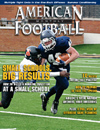Article CategoriesAFM Magazine
|
GEORGE BLANDA “It’s Never Too Late”© More from this issueBy T. J. Troup Future Hall of Fame Quarterback Bobby Layne was sold to the New York Bulldogs before the 1949 season by “Papa Bear” George Halas. To fill the roster spot, Halas used the Bears 12th pick in the draft to take quarterback George Blanda of Kentucky. During his last three years at Kentucky, playing under the legendary Paul “Bear” Bryant, the Wildcats won 20 of 31 games and played in their first bowl game after the 1947 season.
|
|
|||||||
| HOME |
MAGAZINE |
SUBSCRIBE | ONLINE COLUMNISTS | COACHING VIDEOS |
Copyright 2025, AmericanFootballMonthly.com
All Rights Reserved





